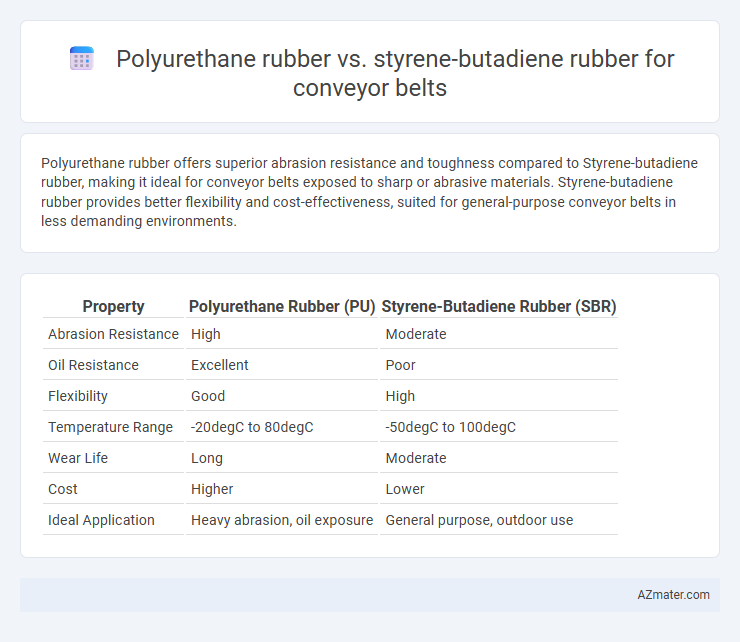Polyurethane rubber offers superior abrasion resistance and toughness compared to Styrene-butadiene rubber, making it ideal for conveyor belts exposed to sharp or abrasive materials. Styrene-butadiene rubber provides better flexibility and cost-effectiveness, suited for general-purpose conveyor belts in less demanding environments.
Table of Comparison
| Property | Polyurethane Rubber (PU) | Styrene-Butadiene Rubber (SBR) |
|---|---|---|
| Abrasion Resistance | High | Moderate |
| Oil Resistance | Excellent | Poor |
| Flexibility | Good | High |
| Temperature Range | -20degC to 80degC | -50degC to 100degC |
| Wear Life | Long | Moderate |
| Cost | Higher | Lower |
| Ideal Application | Heavy abrasion, oil exposure | General purpose, outdoor use |
Introduction to Conveyor Belt Materials
Polyurethane rubber and styrene-butadiene rubber (SBR) are common materials used in conveyor belt manufacturing, each offering distinct properties suitable for different industrial applications. Polyurethane rubber provides excellent abrasion resistance, high tensile strength, and superior resistance to oil and chemicals, making it ideal for heavy-duty, high-wear environments. Styrene-butadiene rubber features good flexibility, cost-effectiveness, and resistance to aging and heat, often preferred for general-purpose conveyor belts in moderate conditions.
What is Polyurethane Rubber?
Polyurethane rubber is a versatile elastomer known for its exceptional abrasion resistance, elasticity, and resistance to oils and chemicals, making it ideal for conveyor belts in demanding industrial environments. It offers superior durability and load-bearing capacity compared to styrene-butadiene rubber (SBR), which is more prone to wear and less resistant to chemicals. Polyurethane rubber conveyor belts provide enhanced operational lifespan and reduced maintenance costs in applications requiring toughness and flexibility.
What is Styrene-Butadiene Rubber (SBR)?
Styrene-Butadiene Rubber (SBR) is a synthetic elastomer commonly used in conveyor belts due to its excellent abrasion resistance and aging stability. It consists of copolymerized styrene and butadiene monomers, providing balanced mechanical properties such as high tensile strength and good flexibility. SBR is often preferred in conveyor belt applications requiring durability and resistance to wear, especially in abrasive environments.
Mechanical Properties Comparison
Polyurethane rubber offers superior abrasion resistance and tensile strength compared to styrene-butadiene rubber (SBR), making it ideal for heavy-duty conveyor belt applications subject to high wear and tear. SBR exhibits better flexibility and impact resistance but generally has lower durability under mechanical stress, limiting its use in abrasive environments. The enhanced load-bearing capacity and elongation at break of polyurethane improve conveyor belt longevity and performance in demanding industrial settings.
Abrasion Resistance: Polyurethane vs SBR
Polyurethane rubber exhibits superior abrasion resistance compared to Styrene-butadiene rubber (SBR), making it ideal for conveyor belts exposed to harsh wear conditions. Polyurethane's molecular structure provides enhanced durability and longer service life under abrasive loads, reducing maintenance costs and downtime. In contrast, SBR offers moderate abrasion resistance but tends to wear out faster in high-friction environments.
Chemical Resistance and Environmental Suitability
Polyurethane rubber exhibits superior chemical resistance to oils, solvents, and abrasion compared to Styrene-butadiene rubber (SBR), making it ideal for conveyor belts exposed to harsh industrial chemicals. SBR offers better flexibility and is more resistant to aging and weather conditions such as ozone and UV exposure, which ensures enhanced environmental suitability for outdoor conveyor applications. Choosing polyurethane rubber maximizes durability in chemically aggressive environments, while SBR prioritizes resilience in fluctuating weather and temperature conditions.
Flexibility and Longevity in Conveyor Belts
Polyurethane rubber offers superior flexibility and exceptional abrasion resistance, making it ideal for conveyor belts operating under dynamic bending and heavy loads. Styrene-butadiene rubber (SBR) provides good tensile strength but tends to have lower flexibility and reduced longevity when exposed to harsh environmental conditions and repeated flexing. Choosing polyurethane rubber enhances conveyor belt durability and operational lifespan by maintaining elasticity and resisting wear in demanding industrial applications.
Cost Analysis: Polyurethane Rubber vs SBR
Polyurethane rubber typically incurs higher initial costs compared to Styrene-butadiene rubber (SBR) due to its superior abrasion resistance and longer service life in conveyor belt applications. While SBR offers a more budget-friendly upfront investment, its lower durability often results in increased maintenance and replacement expenses over time. Evaluating the total cost of ownership, polyurethane rubber can prove more economical for heavy-duty operations despite its premium price.
Typical Applications in Conveyor Systems
Polyurethane rubber excels in conveyor belts used for food processing, packaging, and abrasive material handling due to its superior abrasion resistance and chemical inertness. Styrene-butadiene rubber (SBR) is commonly employed in general-purpose conveyor belts within mining, agriculture, and bulk material conveyor systems because of its cost-effectiveness and good mechanical properties. Conveyor systems in harsh environments often select polyurethane for its durability, while SBR suits applications requiring moderate wear resistance and flexibility.
Choosing the Right Rubber for Your Conveyor Belt
Selecting the right rubber for conveyor belts depends heavily on the application environment and performance requirements. Polyurethane rubber offers superior abrasion resistance, high tear strength, and excellent flexibility, making it ideal for heavy-duty operations with sharp or abrasive materials. Styrene-butadiene rubber (SBR) is more cost-effective, provides good resistance to heat and aging, and performs well in general-purpose conveyor belts where chemical resistance and elasticity are essential.

Infographic: Polyurethane rubber vs Styrene-butadiene rubber for Conveyor belt
 azmater.com
azmater.com